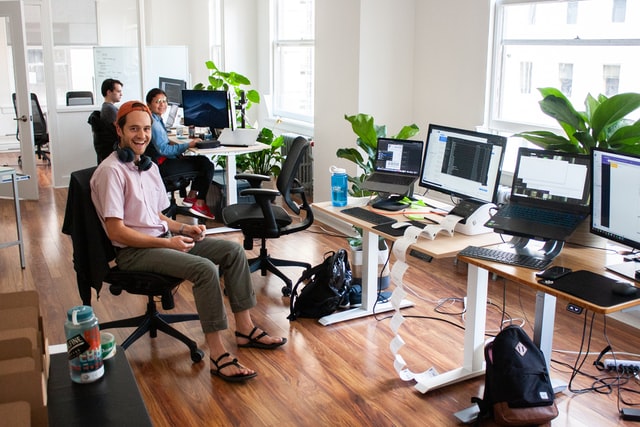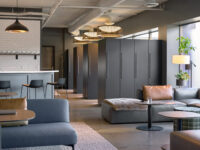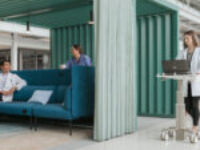Remote Vs. In-Office: How Can They Compare?
As the average worker has found themselves working from home more often these days, it’s becoming harder for employees to feel the same comfort and convenience at the office that they grew to know and love during mandated lockdowns. This shift in work preference has many businesses trying to compromise by offering hybrid work schedules and offer alternative solutions that foster engagement with their fellow colleagues in an effort to maintain their unique culture.
The fact of the matter is, the future workspace is one that empowers collaboration and camaraderie. No matter how your organization strives to accommodate employees, remember there are a variety of ways to approach your commercial space transformation. Our designers are all too familiar with helping local Columbus businesses reconfigure their offices, lobbies, and open spaces to meet the needs of today’s workforce while maximizing the return on your real estate investment.
But what does that look like? And why should commercial spaces be renovated when employees are there less? In this article, we share our latest insights on how commercial spaces will evolve in 2022 and beyond.
Why Workspaces Need To Be Better When Employees Are There Less
There is nothing worse than going from working in your comfy home office to having to wake up early, commuting to work, all to sit in an uninspiring, cold office or cubicle for eight hours. The lack of comfortable seating and functional design alone is enough to make any employee choose their WFH setup over coming into work everyday. With this top of mind, employers need to do their part by converting workspaces into productive – and engaging – environments that are designed to offer a variety of work settings. Allowing the employee to transition from focus work to team and collaborative work is just one step in setting up your staff for success.
A key part to crafting the future workplace is understanding how your work environment either detracts or enhances worker productivity. We know that in each job function there are varying degrees of privacy, technology access and user choice desired by workers. Both generational differences and employee tenure impact how people experience space therefore, businesses should ideate how to create an inclusive, hybrid environment that is both comfortable and productive for all.
Pulling the trigger on redesigning your workspace can be intimidating. We suggest starting a conversation with your employees to gauge what they’d like to see out of their work environment. Our live design and commercial space planning capabilities help businesses by streamlining the process. By visualizing your space in real time, we are able to guide you to the right solution for your goals, space and budget.

Office Amenities
Companies like Google have set the bar high when it comes to giving employees everything they need in one place. Childcare, self care, bars, restaurants, and even beds. While this may work for them to encourage employees to work long hours, it’s not for every business. People are beginning to discover the importance of a work/life balance; 63% of them have expressed they value a healthy work/life balance over compensation and benefits. This alone should be enough to make company decision makers ask themselves, “What work/life balance am I offering my team?”
Different employees favor different amenities, but one of the biggest perks businesses can offer is flexibility. We know, since the pandemic began, 5% of working mothers have found themselves unable to rejoin the workforce due to the lack of childcare in their area. Additionally, we know workers struggle to solve day care issues for either their new pandemic pet, aging parents or ill family members. In a time where labor shortages are high, companies must think outside the box when it comes to providing different benefits that help people achieve work/life balance. Remote work and a flexible work environment can offer that needed balance.

Culture Shift
We all know the old adage, “Culture will eat strategy for lunch”. For some companies the pandemic strengthened their understanding of culture, for others the pandemic brought to light the need for a cultural shift. Now more than ever businesses are focusing on how their culture affects employees and what that means for success. A healthy, supportive work environment has three pillars:
- Trust
- Shared information
- The opportunity to choose how (and where) employees work
When evaluating your real estate and how it improves workplace culture, consider this: productivity should no longer be measured by the amount of time an employee spends at their desk, but rather the outcome of their work. Being intentional about expectations and demonstrating your ability to trust your teams to choose the right setting is a refreshing shift many commercial spaces benefit from. Today’s high performing workplace offers focus zones, collaborative or team zones and social zones that support team health and company culture from many angles. If you’re unsure of how to strengthen the culture at your own business through offering a variety of work zones we suggest starting with your department leads and talk about what areas of your space are underutilized and should be reimagined.
Hybrid And WFH Put To Practice
Chances are, your employees take pride in their work. Help your team succeed by creating a reasonable hybrid or total WFH plan so they know what’s expected of them. Even if your employees are spending more than half of their time WFH, it’s important to identify opportunities that improve working environments for when the team is in the office. Get a head start on your commercial space planning with a custom quote from our Columbus office and see how easy it is to transform your workplace into a space where employees prefer to spending their time.



